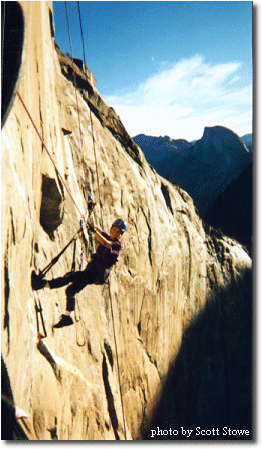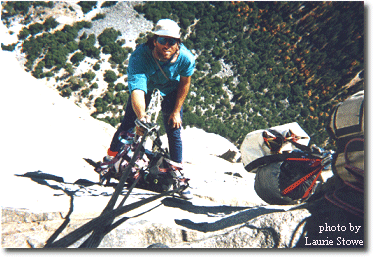|
|||||||
| What You Can Do | Current Closures | Safety | Emergencies | Big Walls | Wilderness Permits | Conservation/ Regulations | Guides |
|
|||||||
| What You Can Do | Current Closures | Safety | Emergencies | Big Walls | Wilderness Permits | Conservation/ Regulations | Guides |
 Yosemite
is one of the world's greatest climbing areas. Climbers
here can enjoy an endless variety of challenges- from the
sustained crack climbs of the Merced river canyon to
pinching crystals on sun drenched Tuolumne domes to
multi-day aid climbs on the big walls of the
Valley. Yosemite is not just a climber's
playground, however- Its walls and crags are an integral
part of a larger ecosystem, protected as wilderness, that
was set aside for people to enjoy in a natural state for
generations to come. Yosemite
is one of the world's greatest climbing areas. Climbers
here can enjoy an endless variety of challenges- from the
sustained crack climbs of the Merced river canyon to
pinching crystals on sun drenched Tuolumne domes to
multi-day aid climbs on the big walls of the
Valley. Yosemite is not just a climber's
playground, however- Its walls and crags are an integral
part of a larger ecosystem, protected as wilderness, that
was set aside for people to enjoy in a natural state for
generations to come.As the
number of climbers visiting the park has increased
through the years, the impacts of climbing have become
much more obvious. Some of those impacts include:
soil compaction, erosion, and vegetation loss in parking
areas, at the base of climbs, and on approach and descent
trails, destruction of cliffside vegetation Your help is needed to ensure that
Yosemite remains a beautiful and healthy place for the
future. |
What you can do
1. Read and follow the guidelines and regulations in the conservation section of this page.
2. If you see climbers who are not following these guidelines, talk to them. Explain how they can minimize their impact, and why it is important that they do so.
3. Clean up after others. Pick up trash when you see it, or return with friends on a rest day and do a thorough clean-up. Take part in organized clean-ups and other projects.
4. Climb safely! Rescues endanger rescuers'
lives, are expensive, and cause a lot of impact. Read the safety
section of this page and the "staying alive"
section of the current valley guidebook.
5. Keep informed about closed areas, and respect these closures.
Current Closures
|
updated 6/18/2000 - call the Yosemite Public Information Office during business hours for the most current closure information at (209) 372-0200. 1. Due to recent and ongoing rockfall, Glacier Point
Apron west of Monday Morning slab is closed to climbing.
Climbing anywhere on Glacier Point Apron is not recommended due to
rockfall danger.
2. Restrictions near peregrine falcon nest sites are in
effect January 1 through August 1 for Lower Cathedral Rock, Rhombus
Rock, the east side of Glacier Point, and Hetch Hetchy Valley. Check
bulletin boards at Camp 4 and the Mountain Shop at Curry Village for
specific information. |
Safety
 More than 100 climbing accidents occur in Yosemite each
year; of these, 15-25 parties require a Park Service
rescue. Climbing in Yosemite has inherent risks and
climbers assume complete responsibility for their own safety. The
Park Service does not maintain routes; loose rock and other
hazards can exist on any route. Rescue is not a certainty. If you
get into difficulties, be prepared to get yourself out of them.
Know what to do in any emergency, including injuries,
evacuations, unplanned bivouacs, or rapid changes in weather.
Safety depends on having the right gear and the right attitude.
Practice self-rescue techniques before you need them!
Courtesy is an element of safety. Falling rock or gear is a
serious hazard. Be careful when climbing above others. Do not
create a dangerous situation by passing another party without
their consent. Be sure to read the section on "Staying
Alive" in the Yosemite Valley guidebook.
More than 100 climbing accidents occur in Yosemite each
year; of these, 15-25 parties require a Park Service
rescue. Climbing in Yosemite has inherent risks and
climbers assume complete responsibility for their own safety. The
Park Service does not maintain routes; loose rock and other
hazards can exist on any route. Rescue is not a certainty. If you
get into difficulties, be prepared to get yourself out of them.
Know what to do in any emergency, including injuries,
evacuations, unplanned bivouacs, or rapid changes in weather.
Safety depends on having the right gear and the right attitude.
Practice self-rescue techniques before you need them!
Courtesy is an element of safety. Falling rock or gear is a
serious hazard. Be careful when climbing above others. Do not
create a dangerous situation by passing another party without
their consent. Be sure to read the section on "Staying
Alive" in the Yosemite Valley guidebook.
Emergency Information
The Yosemite Medical Clinic, located between Yosemite Village and the Church Bowl, is fully equipped to handle climbing injuries. If you cannot get to the clinic on your own, dial "911" on any Yosemite telephone for assistance.
If you are injured or stranded while on a climb and cannot self-rescue, yell for help to obtain assistance. If you require a helicopter evacuation, do only and exactly what you are told by rescue personnel.
If you require a rescue, and it is determined
that your own negligence got you into trouble, you may be charged
with "creating
a hazardous condition" . There is no climber registration in
Yosemite. The Park Service is not watching out for you...you're
on your own.
Big Walls
Carry a dry bag, plastic container, or "poop tube" for human waste. After your climb, dump the waste in a pit toilet. Paper bags are acceptable; plastic bags are not.
Re-read "Staying Alive" in the guide and bring adequate gear. Rescues are dangerous, expensive, and cause a lot of impact.
Wilderness Permits
At the current time, wilderness permits are not required for nights spent on a wall. It is illegal to camp at the base of any wall in Yosemite Valley. If you must bivouac on the summit, you are required to follow all regulations:
Do not litter, toss, or cache anything. If you hauled it up, you can carry it down.
If you must have a fire, use an existing fire ring.
Do not build windbreaks, platforms, or other "improvements".
Half Dome: Camping at the base of Half Dome is legal, but a wilderness permit is required. They can be obtained at the Wilderness Center next to the Post Office in Yosemite Village. To have the best chance of getting one, go there early in the morning the day before you hike up. Camping on the summit of Half Dome is prohibited.
Conservation/Regulations
Fight litter! Don't toss anything off a wall, even if you intend to pick it up later. Don't leave food or water at the top or on ledges "for future parties". Set a good example by picking up any litter you see, including tape wads and cigarette butts.
Don't leave fixed ropes as permanent fixtures on approaches and descents. These are considered abandoned property and will be removed.
Minimize erosion on your approach and descent. If an obvious main trail has been created, use it. Go slow on the way down to avoid pushing soil down the hill. Avoid walking on vegetation whenever possible.
If you need to build a fire for survival during an unplanned bivouac on the summit, use an existing fire ring. Building a new fire ring or windbreak is prohibited. Make sure your fire is completely out before you leave.
Clean extra, rotting slings off anchors when you descend. Bring earth-toned slings to leave on anchors.
Check the Camp 4 Kiosk or the Mountain Shop for the current Peregrine Falcon closures.
On first ascents: Please think about the impacts that will be caused by your new climb- Is the approach susceptible to erosion? Is there a lot of vegetation on the rock? "Gardening", e.g. killing plants, is illegal in Yosemite. Can the climb be done with a minimum of bolts? Motorized drills are prohibited.
Climbing Instruction and Guide Service
Contact Yosemite Mountaineering School at (209)372-1000 for information on rates and schedules.
![]()
http://www.nps.gov
File created 9/99 Hayes Roberts
Updated
Yosemite National Park Division
of Interpretation